In Wisconsin, yellow birds are quite common during the arrival of warblers in spring and summer. However, during winter, the American Goldfinch is the only yellow bird that is frequently seen here.
To assist you in identifying the yellow birds you spot in Wisconsin, this guide provides you with pictures, identification information, song recordings, and migration details.
Warblers, orioles, and tanagers are the most common yellow birds found in Wisconsin, and sometimes the females of these species look strikingly different from the males.
By utilizing the information provided in this guide, identifying yellow birds will become much easier for you. The list of yellow birds is arranged according to their frequency of sightings in Wisconsin during spring and summer, based on ebird checklists for May and June.
Yellow birds present in Wisconsin throughout the year include the American Goldfinch.
Yellow birds found in Wisconsin during the summer include the Common Yellowthroat, Cedar Waxwing, Baltimore Oriole, Yellow Warbler, American Redstart, Nashville Warbler, Eastern Meadowlark, Black-throated Green Warbler, Scarlet Tanager, Yellow-throated Vireo, Pine Warbler, Blue-winged Warbler, Orchard Oriole, Dickcissel, Yellow-headed Blackbird, Canada Warbler, Prothonotary Warbler, Hooded Warbler, Western Meadowlark, and White-eyed Vireo.
During the winter in Wisconsin, the Evening Grosbeak is the only yellow bird that can be commonly observed.
Yellow birds passing through Wisconsin during migration include the Yellow-rumped Warbler, Palm Warbler, Magnolia Warbler, Wilson’s Warbler, Cape May Warbler, and Orange-crowned Warbler.
Continue reading to learn how to identify the yellow birds you have spotted.
28 Yellow Birds in Wisconsin:
1. American Goldfinch
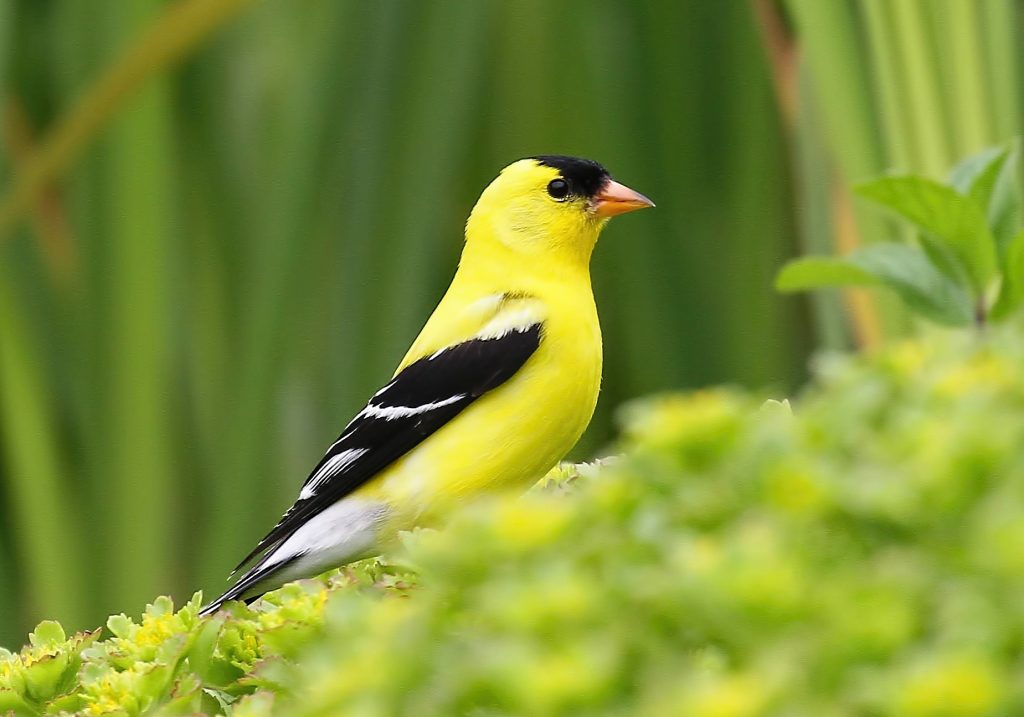
Throughout the year, American Goldfinches can be found in Wisconsin. They are recorded in 46% of summer checklists and 33% of winter checklists submitted by birdwatchers in the state.
American Goldfinches are highly popular birds. In spring, the males display vibrant yellow and black plumage, while the females appear duller brown. During winter, both males and females have a more subdued coloration.
Scientific name: Spinus tristis
Length: 4.3-5.1 inches (11-13 cm)
Weight: 0.4-0.7 ounces (11-20 g)
Wingspan: 7.5-8.7 inches (19-22 cm)
American Goldfinches can be found across most of North America and are typically resident throughout the year. However, those that breed in Canada and the Midwest migrate to the southern US states during winter.
You can spot American Goldfinches in weedy fields, overgrown areas, suburbs, parks, and even in backyards. They forage on sunflower, thistle, and aster plants.
Song of the American Goldfinch:
American Goldfinch nests are usually built in saplings or shrubs. They are constructed using grass, bark strips, and feathers, and the female lays four to six eggs. The eggs take around ten to twelve days to hatch, and while the male feeds the female, she incubates the eggs.
To attract American Goldfinches to your backyard, consider planting thistles and milkweed. They are known to visit most bird feeders and have a preference for sunflower seeds and nyjer seed.
Fun fact: Brown-headed Cowbirds lay their eggs in American Goldfinch nests, but unfortunately, the seed-based diet provided by the parents is unsuitable for the cowbird chicks, resulting in their eventual demise.
2. Common Yellowthroat
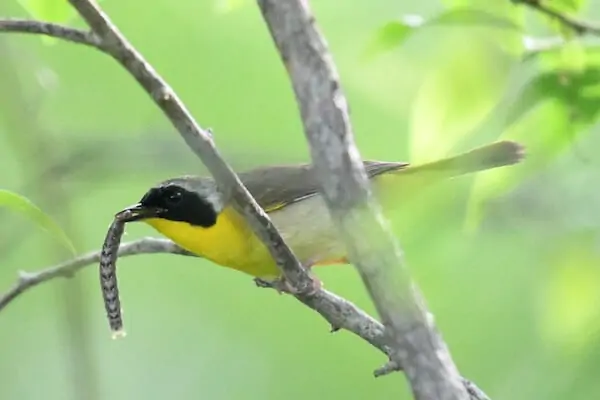
During the breeding season, Common Yellowthroats are frequently observed in Wisconsin. They can be spotted in May and begin their migration in October, appearing in 34% of summer checklists.
Common Yellowthroats are small songbirds with a brownish back and bright yellow undersides. They possess long tails, and the males have black masks across their faces. The intensity of the yellow color may vary geographically, and the undersides can sometimes appear more olive.
Scientific name: Geothlypis trichas
Length: 4.3-5.1 inches (11-13 cm)
Weight: 0.3-0.3 ounces (9-10 g)
Wingspan: 5.9-7.5 inches (15-19 cm)
During summer, Common Yellowthroats breed across most of North America, excluding Alaska and northern Canada. Some individuals remain along the Gulf Coast and Pacific Southwest throughout the year. During migration, they head south.
Common Yellowthroats are often found in marshy or wetland areas, as well as brushy fields with dense vegetation.
Song of the Common Yellowthroat:
Credit: Paul Marvin, XC629250. Available at www.xeno-canto.org/629250.
Nests of Common Yellowthroats are constructed by females near the ground in marshy locations, supported by reeds. These nests are made from grass and sedges, forming a platform of leaves and grass. The female lays up to six eggs, which take approximately twelve days to hatch. The young birds leave the nest after a similar period.
To attract Common Yellowthroats to larger backyards, dense vegetation and native plants that attract insects are recommended.
Fun fact: Common Yellowthroats perceive the black mask of another male as a sign of a potential rival and may attack when decoys without a mask are used, but they show no aggression toward decoys with no mask.
3. Cedar Waxwing
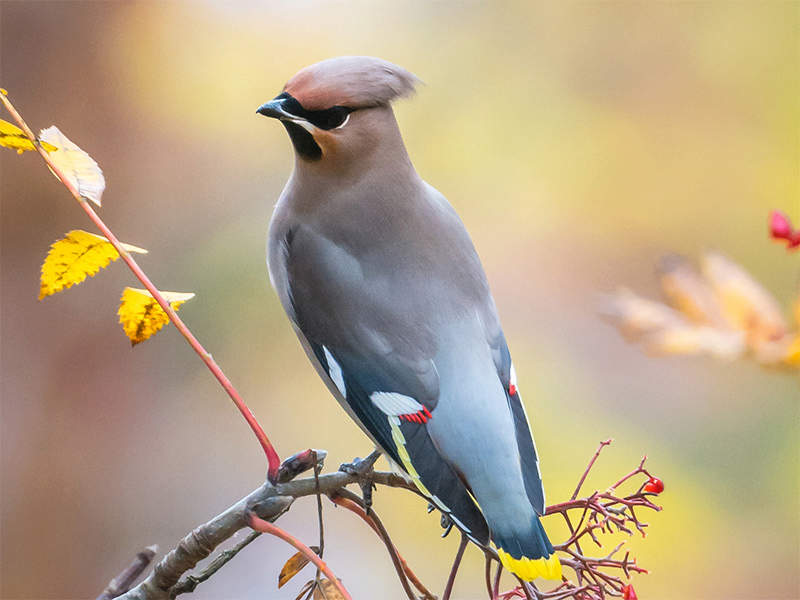
Cedar Waxwings are more commonly seen in Wisconsin during the summer, from May to mid-November, and are observed in 17% of checklists during this period. However, some individuals remain in the southern part of the state throughout the year.
Cedar Waxwings are elegant and sociable birds. They have pale brown heads, chests, and crests, which transition to gray on their backs and wings. The belly is pale yellow, and there are bright yellow tips on the tail. Their eyes are adorned with a narrow black mask, and their wingtips display a vibrant red.
Scientific name: Bombycilla cedrorum
Length: 5.5-6.7 inches (14-17 cm)
Weight: 1.1 ounces (32 g)
Wingspan: 8.7-11.8 inches (22-30 cm)
Cedar Waxwings breed in Canada before migrating to the southern US, Mexico, and Central America for winter. They are also residents throughout the year in the northern US states.
You can find Cedar Waxwings in berry bushes, woodlands, grasslands, towns, and along streams. They primarily feed on fruit, but during summer, they also consume insects.
Call of the Cedar Waxwing:
Credit: Peter Ward and Ken Hall, XC512254. Available at www.xeno-canto.org/512254.
Nests of Cedar Waxwings are built in trees using twigs, grass, hair, and plant materials, lined with pine needles and soft grass. The female lays up to six eggs, which hatch after approximately twelve days. The young birds leave the nest in around sixteen days.
To attract Cedar Waxwings to your backyard, consider planting native trees and shrubs that bear
small fruits, such as serviceberry, dogwood, juniper, winterberry, and hawthorn. You can also try offering fruit on platform feeders.
Fun fact: Cedar Waxwings exchange gifts during courtship, passing items between themselves.
4. Baltimore Oriole (Female)
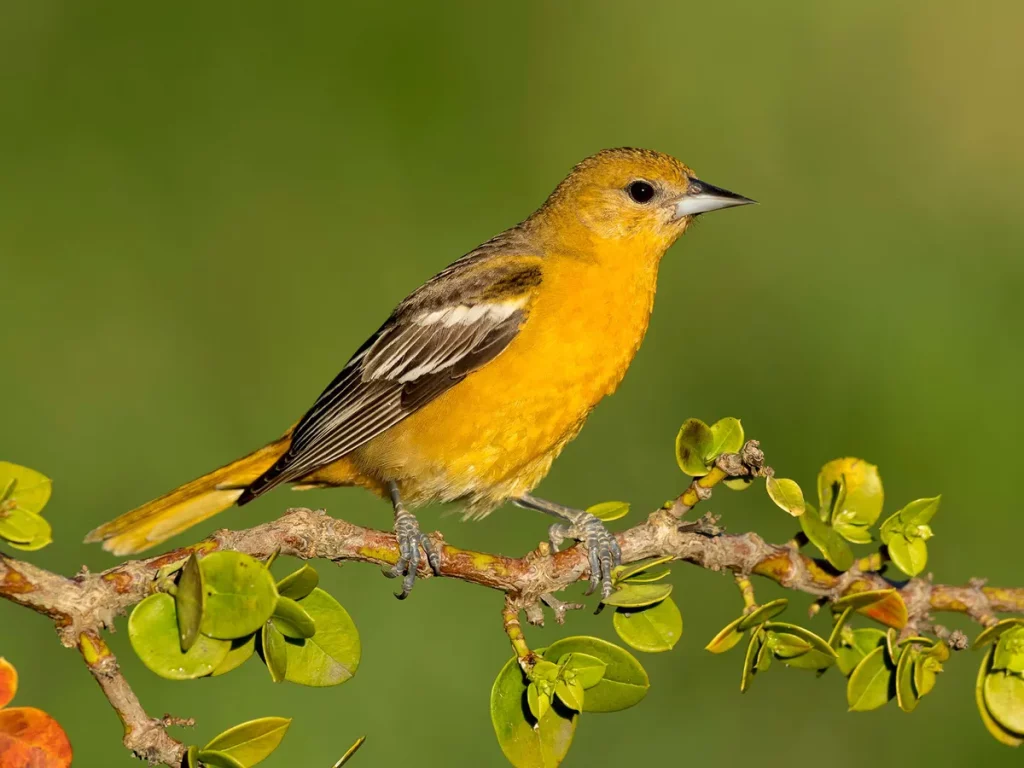
Baltimore Orioles are frequently observed during the breeding season in Wisconsin. They are primarily seen from April to mid-September, with some individuals staying until mid-February. They appear in 29% of summer checklists.
Baltimore Orioles are colorful indicators of spring in the eastern part of North America. Adult males display vibrant orange and black plumage with white wing bars.
Females have yellowish undersides and heads, and their wings are grayish-brown. They are roughly the same size as a Robin but possess a more slender physique. Baltimore Orioles belong to the blackbird family.
Scientific name: Icterus galbula
Length: 6.7-7.5 inches (17-19 cm)
Weight: 1.1-1.4 ounces (30-40 g)
Wingspan: 9.1-11.8 inches (23-30 cm)
Baltimore Orioles breed in eastern and central US states, including central-southern Canadian provinces and the US southern border.
During winter, they migrate to Florida, Central America, and the Caribbean, starting as early as July.
Baltimore Orioles can be found in open woodlands, along riverbanks, and at forest edges. They forage for insects and fruits, often visiting parks and backyards.
Diet-wise, they consume insects such as beetles, crickets, grasshoppers, spiders, and snails. They also help control pest species and enjoy a wide variety of fruits. However, they can cause damage to crops such as raspberries, mulberries, cherries, bananas, and oranges.
Sounds of the Baltimore Oriole: The melodious flute-like song of Baltimore Orioles is one of the delights of spring. They also produce chattering and sharp alarm calls.
Credit: Christopher McPherson, XC690956. Available at www.xeno-canto.org/690956.
To attract Baltimore Orioles to your backyard, try offering halved oranges on a platform feeder or hanging them from trees. Oriole feeders filled with sugar water can also be effective. Planting fruiting plants and nectar-rich flowers such as raspberries, crab apples, and trumpet vines will further entice them.
Fun fact: Baltimore Orioles construct incredible hanging bag-like nests woven from various fibers.
5. Yellow-rumped Warbler
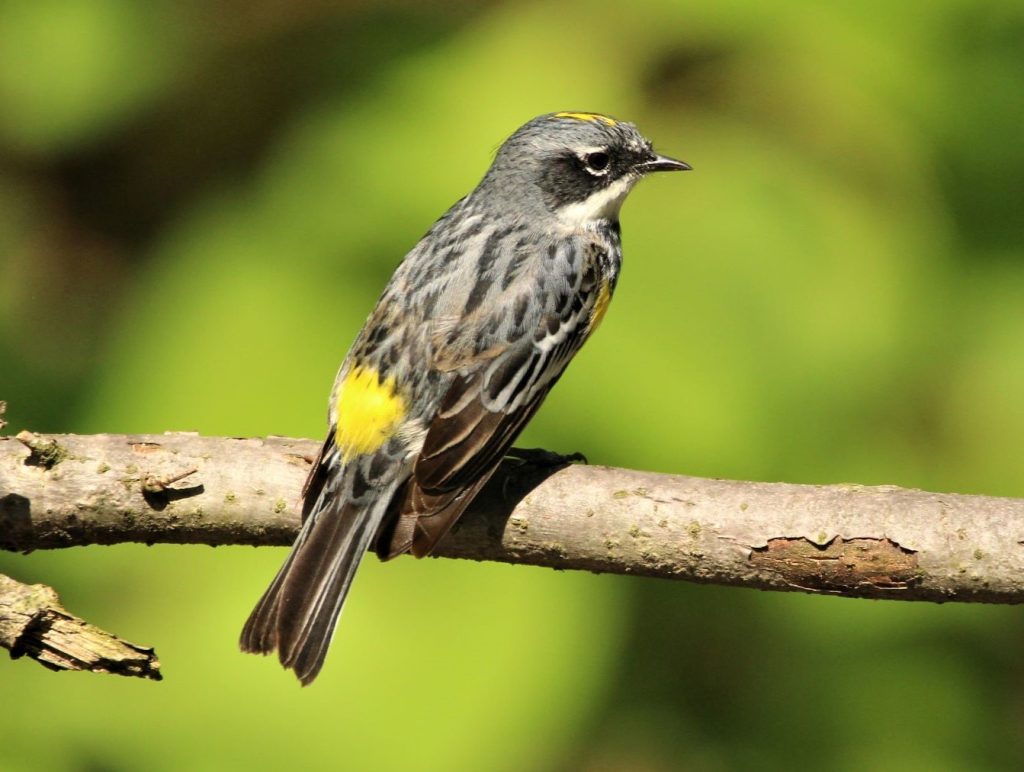
Yellow-rumped Warblers spend the breeding season in northern Wisconsin, but they are more commonly seen during migration throughout the rest of the state. They appear in 14% of summer checklists and up to 41% of checklists during migration.
Yellow-rumped Warblers have a predominantly gray coloration with flashes of yellow on their faces, sides, and rump. Their wings feature white patches.
Females may exhibit slightly brownish tones, while winter birds display paler brown hues with bright yellow rumps and sides. In spring, they transition back to bright yellow and gray.
Scientific name: Setophaga coronata
Length: 4.7-5.5 inches (12-14 cm)
Weight: 0.4-0.5 ounces (12-13 g)
Wingspan: 7.5-9.1 inches (19-23 cm)
Yellow-rumped Warblers primarily breed in Canada, the Rockies, and the Appalachian mountains.
During migration, they can be observed in the Midwest before overwintering in southern and southwestern US states, the Pacific Coast, Mexico, and Central America.
You can spot Yellow-rumped Warblers in coniferous forests, particularly during the breeding season. In winter, they can be found in open areas with fruiting shrubs. During the summer, their diet mainly consists of insects, while in winter, they predominantly feed on fruit such as bayberry and wax myrtle.
Song of the Yellow-rumped Warbler:
Credit: Christopher McPherson, XC602699. Available at www.xeno-canto.org/602699.
Nests of Yellow-rumped Warblers are constructed by females in conifer trees using twigs, pine needles, and grass. The nests are lined with soft grass, moss, and hair. Females lay up to six eggs, which take around two weeks to hatch. The young birds leave the nest after approximately two weeks.
To attract Yellow-rumped Warblers to your backyard, provide sunflower seeds, suet, raisins, and peanut butter.
Fun fact: Yellow-rumped Warblers form flocks numbering in the thousands during winter and can display aggression towards other species that come too close.
6. Yellow Warbler
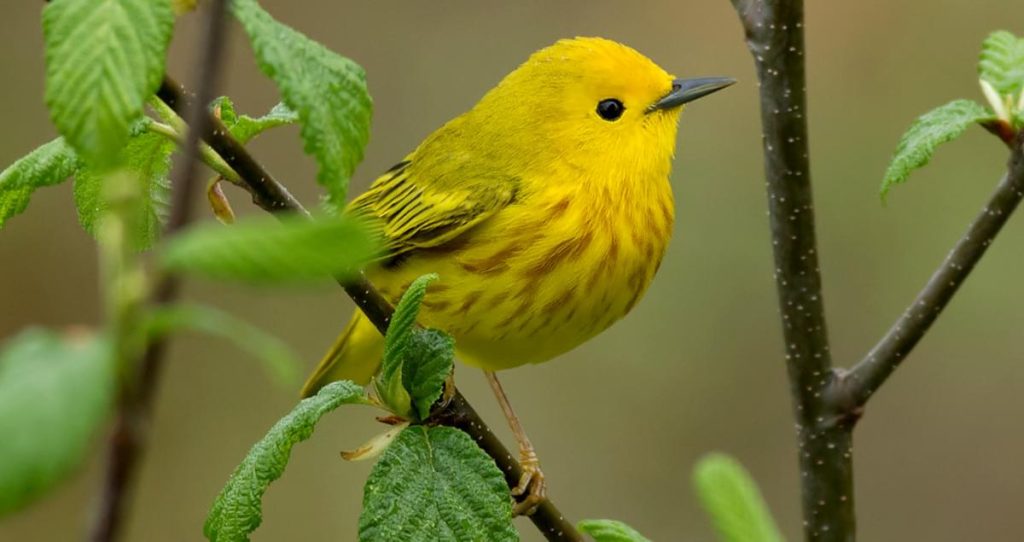
Yellow Warblers breed in Wisconsin and can be spotted from April to October. They appear in 25% of summer checklists.
Yellow Warblers are small, brightly yellow birds with a yellow-green back. Male individuals display chestnut streaks on their breasts. Females and juveniles are not as vibrant as the males.
Scientific name: Setophaga petechia
Length: 4.7-5.1 inches (12-13 cm)
Weight: 0.3-0.4 ounces (9-11 g)
Wingspan: 6.3-7.9 inches (16-20 cm)
Yellow Warblers undertake a long-distance migration to breed in Canada and the US, excluding southeastern states. They then head back to Central and South America for winter. However, they can be seen during migration in southeastern US states.
You can find Yellow Warblers along streams, in wetlands, thickets, and field edges, where they forage for insects such as caterpillars, midges, beetles, bugs, and wasps.
Song of the Yellow Warbler:
Credit: Richard E. Webster, XC662546. Available at www.xeno-canto.org/662546.
Nests of Yellow Warblers are built in small trees or shrubs using bark, grass, and plant materials woven together. The nests are secured with spider webs, forming a cup-shaped structure. The interior is lined with softer materials such as hair, feathers, and plant down.
Yellow Warblers lay up to seven eggs, which take around twelve days to hatch. It takes another ten days for the young birds to leave the nest.
To attract Yellow Warblers to your backyard, offer suet, oranges, peanut butter, and plants that bear berries. Additionally, plant native species that attract insects, and avoid using pesticides or maintaining an overly tidy yard. Providing birdbaths with fountains near secluded planting areas can also provide protection and appeal to them.
Fun fact: When Yellow Warblers detect Brown-headed Cowbird eggs in their nests, they build a new nest on top of the old one and restart the breeding process. This can happen up to six times!
7. American Redstart (Female)
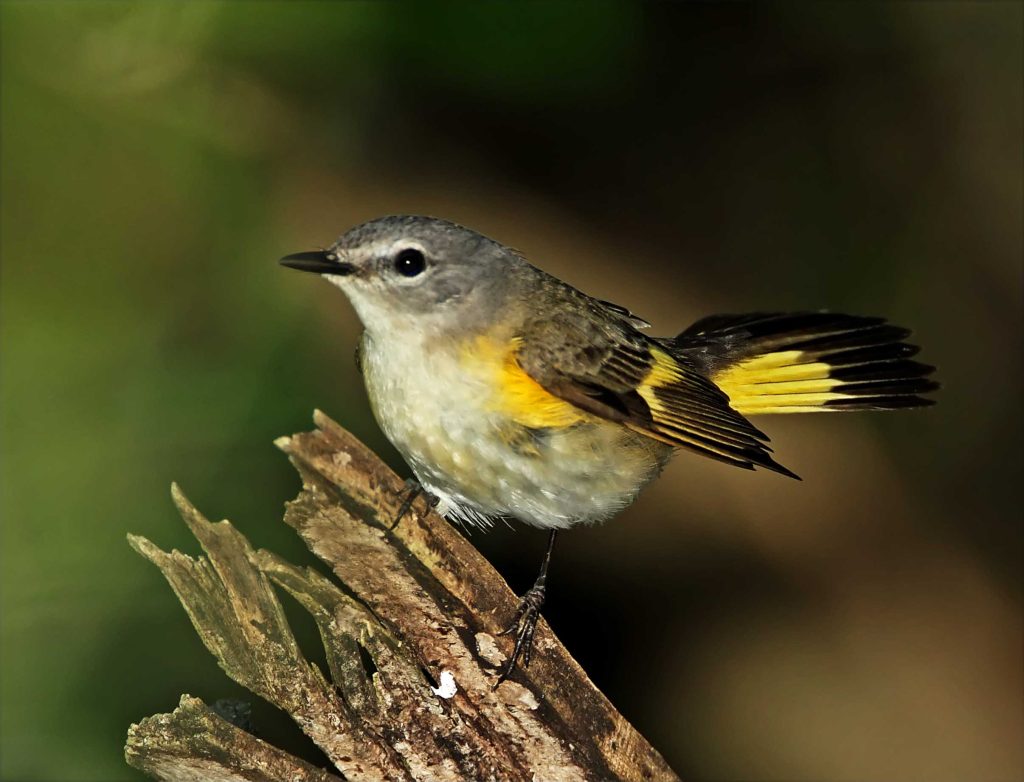
American Redstarts spend the breeding season in Wisconsin and are observed from mid-April to November. They appear in 17% of summer checklists.
Male American Redstarts are primarily black with vibrant orange patches and a white belly. Females exhibit olive-gray coloration instead of black and possess numerous yellow patches.
Scientific name: Setophaga ruticilla
Length: 4.3-5.1 inches (11-13 cm)
Weight: 0.2-0.3 ounces (6-9 g)
Wingspan: 6.3-7.5 inches (16-19 cm)
American Redstarts breed in eastern US states, Canada, northwestern US states, and into British Columbia. They can also be seen during migration in central and western US states.
You can find American Redstarts in deciduous woodlands, backyards, and thickets, where they forage on berries such as serviceberry and magnolia, as well as insects.
Song of the American Redstart: They produce a dropping-pitch song.
Credit: Nick Kiehl, XC522368. Available at www.xeno-canto.org/522368.
Nests of American Redstarts are situated close to tree trunks in trees or large shrubs. They are constructed using bark, grass, and other plant materials. The females lay up to five eggs, which take just under two weeks to hatch. The young birds leave the nest after a week or two.
To attract American Redstarts to your backyard, provide berry plants such as magnolia and serviceberry.
Fun fact: American Redstart parents selectively feed specific chicks rather than feeding them all at once.
8. Nashville Warbler

Nashville Warblers can be spotted in Wisconsin during the summer, from April to October, with a few individuals remaining until December. They are most commonly observed during spring migration, appearing in 22% of checklists at that time.
Nashville Warblers have predominantly yellow undersides with white lower bellies. They possess a greenish-yellow back and a gray head with a white eyering. Females and juveniles are less vibrant than males.
Scientific name: Leiothlypis ruficapilla
Length: 4.3-5.1 inches (11-13 cm)
Weight: 0.2-0.5 ounces (6.7-13.9 g)
Wingspan: 6.7-7.9 inches (17-20 cm)
Nashville Warblers breed in northeastern US states, Canada, and a smaller population can be found in northwestern US states and British Columbia. They can also be seen during migration in most US states. During winter, they primarily reside in Mexico.
You can find Nashville Warblers in scrubby habitats and low deciduous forests as they search for insects.
Song of the Nashville Warbler:
Credit: Peter Ward and Ken Hall, XC512262. Available at www.xeno-canto.org/512262.
Nests of Nashville Warblers are hidden in shrubs close to the ground. They are constructed using grass, sedge, and ferns, woven into a cup shape and lined with soft grass, feathers, and animal hair. The female lays around four eggs.
To attract Nashville Warblers to your backyard during their migration through Wisconsin, provide suet.
Fun fact: Young Nashville Warblers migrate along the Atlantic Coast in their first year but switch to an inland migration pattern afterward.
9. Palm Warbler

Palm Warblers can be spotted in Wisconsin during migration, primarily from April to May and September to October.
Palm Warblers have a rusty red patch on the top of their heads and exhibit a browny-olive coloration throughout the rest of their bodies. While they breed in Canada, they can also be found in eastern US states during migration. In addition, they can be seen year-round along the far southern coast and in Florida.
Scientific name: Setophaga palmarum
Length: 4.7-5.5 inches (12-14 cm)
Weight: 0.3-0.5 ounces (7-13 g)
Wingspan: 7.9-8.3 inches (20-21 cm)
Palm Warblers predominantly breed in Canada and can be observed during migration
in eastern US states. Some individuals spend their winters in Florida and along the southeastern coast.
You can spot Palm Warblers primarily during the spring and fall migration in weedy fields, forest edges, and scrubby areas. They often forage on the ground, mixed in with other birds such as Sparrows, Juncos, and Yellow-rumped Warblers.
Song of the Palm Warbler:
Credit: Richard E. Webster, XC189604. Available at www.xeno-canto.org/189604.
Nests of Palm Warblers are situated in bogs and boreal forests on the ground. They are constructed using grass, sedge, and ferns, woven into a cup shape and lined with soft grass, feathers, and animal hair. The female lays around five eggs.
To attract Palm Warblers to your backyard, plant native species that attract insects, as well as bayberry or hawthorn for their berries.
Fun fact: Unlike most warblers, Palm Warblers often walk on the ground, bobbing their tails while searching for insects.
10. Eastern Meadowlark
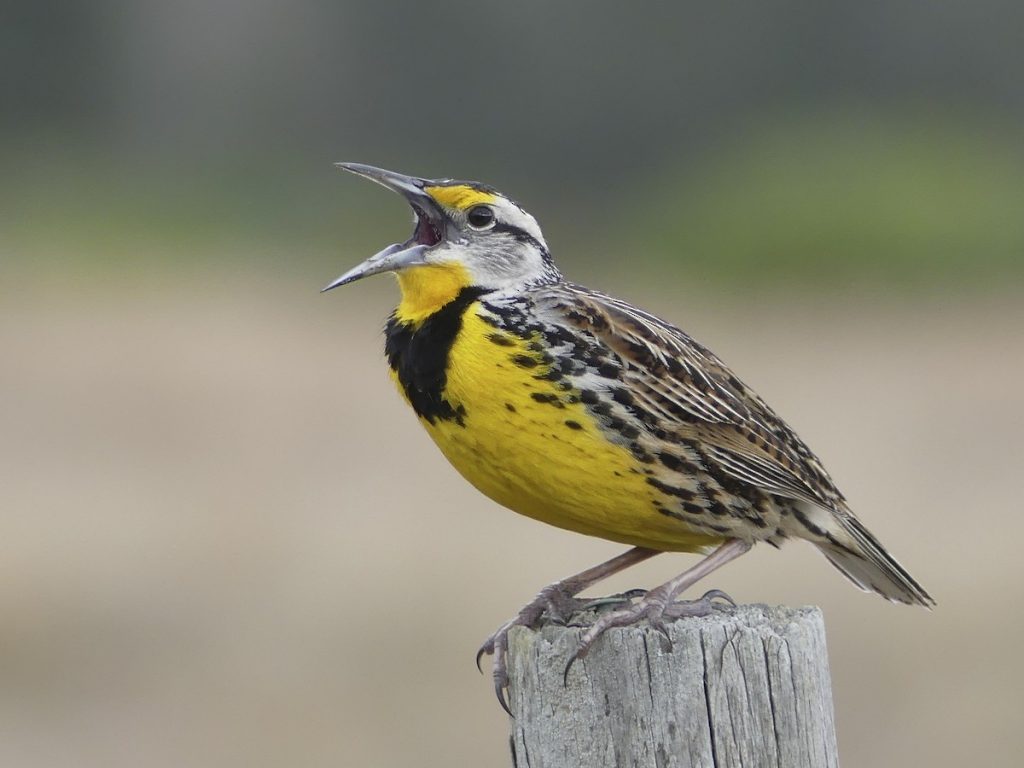
Eastern Meadowlarks are a species classified as near-threatened, but they can be observed in Wisconsin during the summer, appearing in 8% of checklists at this time.
Eastern Meadowlarks are medium-sized songbirds with bright yellow undersides and pale brown plumage featuring black marks on their backs. They possess a distinctive black band across their chests.
Scientific name: Sturnella magna
Length: 7.5-10.2 inches (19-26 cm)
Weight: 3.2-5.3 ounces (90-150 g)
Wingspan: 13.8-15.8 inches (35-40 cm)
Eastern Meadowlarks can be found across eastern US states throughout the year. They also breed in the Northeast and Canada before migrating south.
The arrival of spring in the East is often marked by the melodious singing and displays of Eastern Meadowlarks. Unfortunately, they are currently classified as near-threatened.
You can find Eastern Meadowlarks on the ground in grasslands and prairies, where they feed on insects. During winter, they gather in large flocks in fields, searching for seeds.
Sounds of the Eastern Meadowlark: They produce clear and melodious flute-like whistles.
Credit: Manuel Grosselet, XC645468. Available at www.xeno-canto.org/645468.
Nests of Eastern Meadowlarks are constructed on the ground and can be quite elaborate, featuring tunnels and roofs made of woven grasses.
Fun fact: Eastern Meadowlarks can sing more than 100 different songs.
11. Black-throated Green Warbler

Black-throated Green Warblers can be spotted in Wisconsin during migration, primarily in spring and fall. They are recorded in 12% of checklists during migration.
Black-throated Green Warblers are small songbirds with bright yellow undersides and olive-green upperparts. The males have a black throat and face, while the females display lighter markings.
Scientific name: Setophaga virens
Length: 4.7-5.1 inches (12-13 cm)
Weight: 0.3-0.4 ounces (9-11 g)
Wingspan: 7.1-7.9 inches (18-20 cm)
Black-throated Green Warblers breed in the northeastern United States and into Canada. During migration, they can be observed in various parts of the United States.
You can find Black-throated Green Warblers in coniferous and mixed forests, where they forage for insects among the tree foliage.
Song of the Black-throated Green Warbler:
Credit: Greg Irving, XC586552. Available at www.xeno-canto.org/586552.
Nests of Black-throated Green Warblers are built by females on horizontal tree branches using twigs, grass, and plant fibers. The nest is lined with feathers, animal hair, and moss. They lay around four eggs, which hatch after approximately two weeks. The young birds fledge the nest after an additional two weeks.
12. Scarlet Tanager
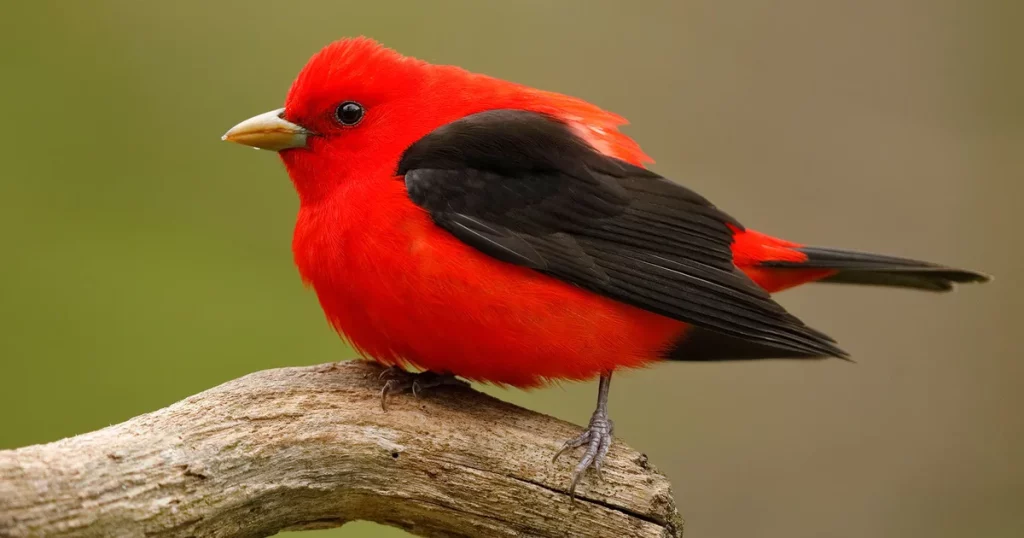
Scarlet Tanagers are migratory birds that can be spotted in Wisconsin during summer, from May to September. They appear in 10% of summer checklists.
Male Scarlet Tanagers are striking with their bright scarlet plumage and jet-black wings and tail. Females and immature birds have olive-green upperparts and yellowish undersides.
Scientific name: Piranga olivacea
Length: 6.3-7.1 inches (16-18 cm)
Weight: 0.9-1.2 ounces (25-34 g)
Wingspan: 9.8-10.6 inches (25-27 cm)
Scarlet Tanagers breed in the eastern United States and parts of Canada. They migrate to northern South America for the winter.
You can find Scarlet Tanagers in deciduous forests, where they forage for insects by hopping through the tree branches.
Song of the Scarlet Tanager:
Credit: Jonathon Jongsma, XC638825. Available at www.xeno-canto.org/638825.
Nests of Scarlet Tanagers are built by females on horizontal branches using twigs, grass, and other plant materials. The nest is lined with finer materials such as rootlets, animal hair, and fine grass. They lay around three to four eggs, which hatch after approximately two weeks. The young birds leave the nest after another two weeks.
13. Yellow-throated Vireo

Yellow-throated Vireos can be spotted in Wisconsin during migration, primarily in spring and fall. They are recorded in 7% of checklists during migration.
Yellow-throated Vireos have yellowish-green plumage on their upperparts, with a yellow throat and white undersides. They also have distinct white wingbars.
Scientific name: Vireo flavifrons
Length: 5.5-5.9 inches (14-15 cm)
Weight: 0.4-0.6 ounces (11-17 g)
Wingspan: 9.1-10.2 inches (23-26 cm)
Yellow-throated Vireos breed in the southeastern United States and parts of Canada. During migration, they can be observed in various parts of the United States.
You can find Yellow-throated Vireos in deciduous and mixed forests, where they forage for insects by actively searching among the leaves.
Song of the Yellow-throated Vireo:
Credit: Matthew G. Hunter, XC385840. Available at www.xeno-canto.org/385840.
Nests of Yellow-throated Vireos are built by females in the fork of tree branches, typically near the trunk. They are constructed using twigs, bark, grass, and other plant materials, and are lined with finer materials such as hair and plant down. They lay around three to five eggs, which hatch after approximately two weeks. The young birds fledge the nest after another two weeks.
14. Pine Warbler
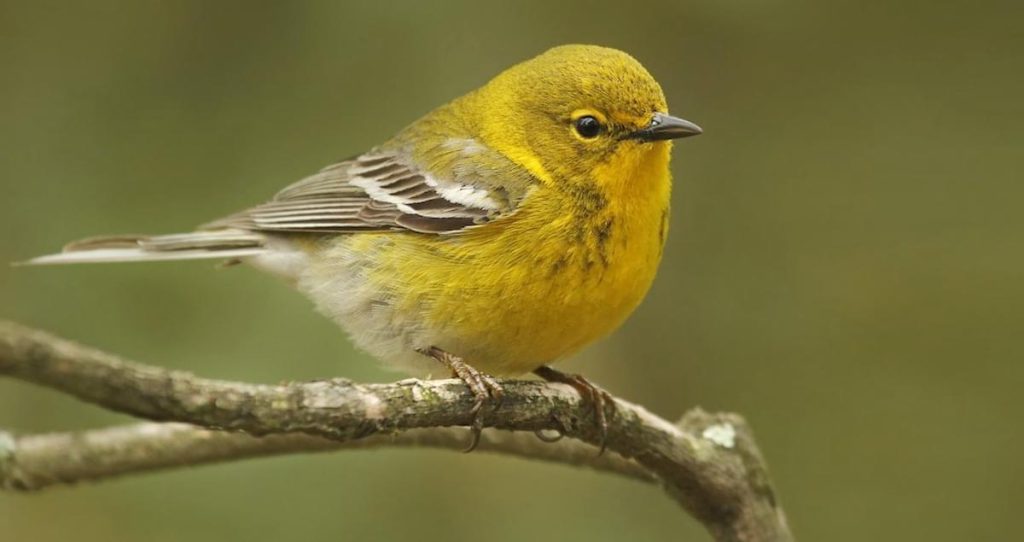
Pine Warblers can be spotted in Wisconsin during migration, primarily in spring and fall. They are recorded in 8% of checklists during migration.
Pine Warblers have olive-green upperparts and pale yellow undersides. They have thin white wingbars and often display streaking on their sides.
Scientific name: Setophaga pinus
Length: 4.7-5.5 inches (12-14 cm)
Weight: 0.3-0.4 ounces (8-11 g)
Wingspan: 8.3-9.1 inches (21-23 cm)
Pine Warblers breed in the northeastern United States and parts of Canada. During migration, they can be observed in various parts of the United States.
You can find Pine Warblers in pine forests, where they forage for insects by actively searching among the branches and needles.
Song of the Pine Warbler:
Credit: Dan Lane, XC577854. Available at www.xeno-canto.org/577854.
Nests of Pine Warblers are built by females high up in pine trees using twigs, pine needles, and grass. The nest is lined with softer materials such as feathers, hair, and fine grass. They lay around three to five eggs, which hatch after approximately two weeks. The young birds fledge the nest after another two weeks.
15. Blue-winged Warbler
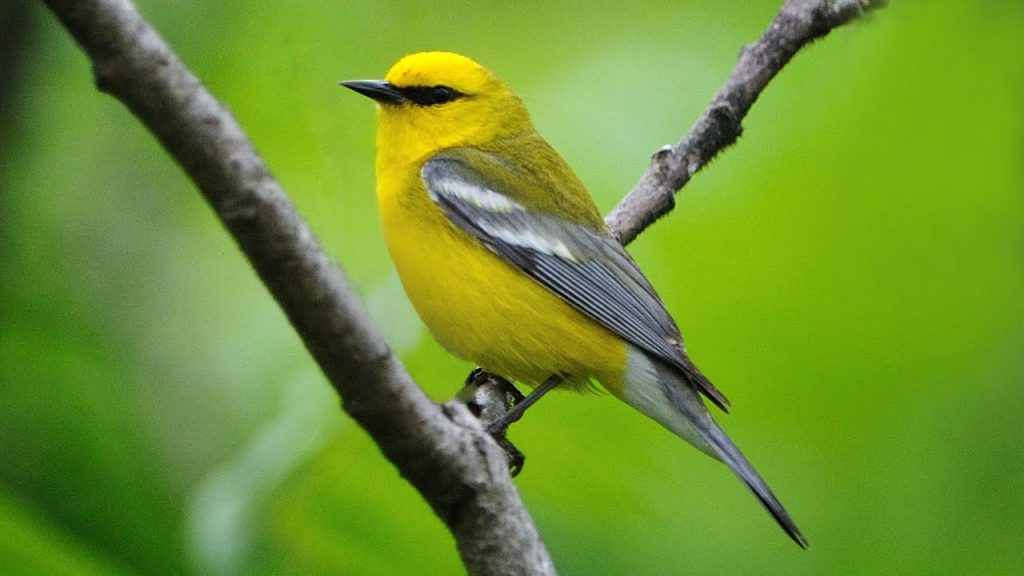
Blue-winged Warblers can be spotted in Wisconsin during migration, primarily in spring and fall. They are recorded in 5% of checklists during migration.
Blue-winged Warblers have bright yellow plumage with distinct black eye-lines and blue-gray wings. They also have a white belly and undertail coverts.
Scientific name: Vermivora cyanoptera
Length: 4.7-5.1 inches (12-13 cm)
Weight: 0.3-0.4 ounces (9-11 g)
Wingspan: 7.5-8.3 inches (19-21 cm)
Blue-winged Warblers breed in the northeastern United States and parts of Canada. During migration, they can be observed in various parts of the United States.
You can find Blue-winged Warblers in open woodlands, shrubby areas, and forest edges, where they forage for insects by actively searching among the vegetation.
Song of the Blue-winged Warbler:
Credit: John C. Mittermeier, XC617652. Available at www.xeno-canto.org/617652.
Nests of Blue-winged Warblers are built by females in low shrubs and saplings, typically in grassy or shrubby habitats. They are constructed using grasses, bark strips, and other plant materials, and are lined with finer materials such as rootlets and hair.
They lay around four to six eggs, which hatch after approximately two weeks. The young birds fledge the nest after another two weeks.
16. Orchard Oriole

Orchard Orioles can be spotted in Wisconsin during summer, from May to August. They appear in 6% of summer checklists.
Male Orchard Orioles have dark chestnut plumage on their heads, necks, and upperparts, while their undersides are bright orange. Females and immature birds have olive-green upperparts and yellowish undersides.
Scientific name: Icterus spurius
Length: 6.3-7.1 inches (16-18 cm)
Weight: 0.7-1.1 ounces (20-31 g)
Wingspan: 9.8-10.6 inches (25-27 cm)
Orchard Orioles breed in the central and eastern United States and parts of Canada. They migrate to Mexico, Central America, and northern South America for the winter.
You can find Orchard Orioles in orchards, open woodlands, and forest edges, where they forage for insects and feed on fruits.
Song of the Orchard Oriole:
Credit: Mike Nelson, XC452475. Available at www.xeno-canto.org/452475.
Nests of Orchard Orioles are built by females high up in trees, typically near the trunk. They are constructed using plant fibers, grasses, and other fine materials, and are lined with softer materials such as hair and feathers. They lay around three to five eggs, which hatch after approximately two weeks. The young birds fledge the nest after another two weeks.
17. Dickcissel
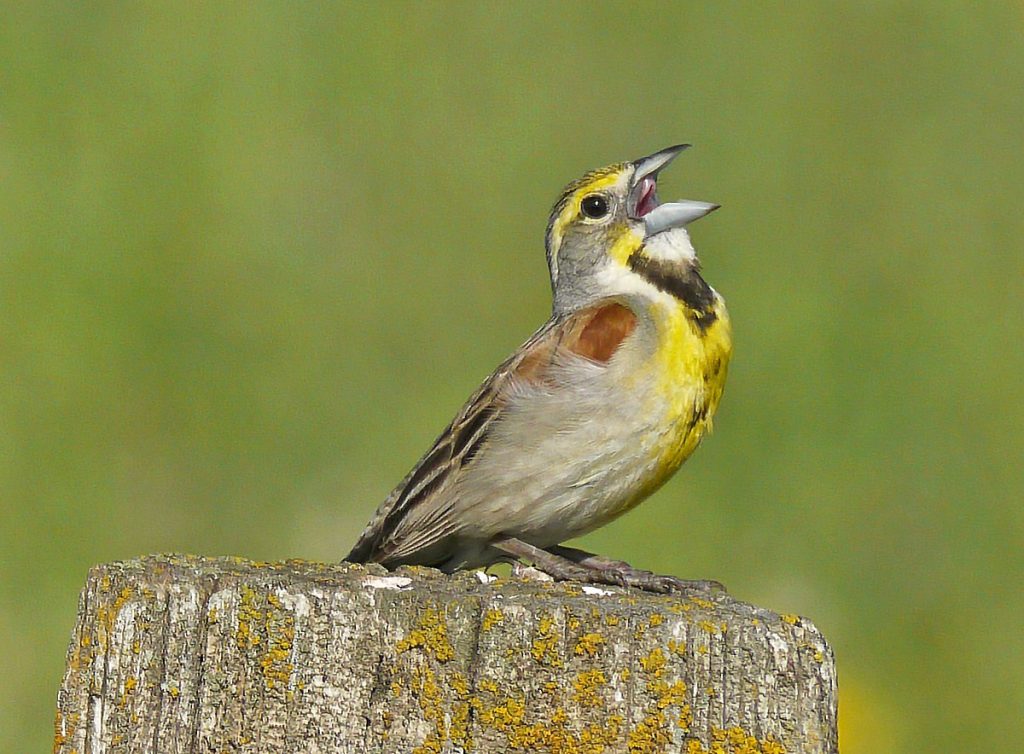
Dickcissels can be spotted in Wisconsin during summer, from May to September. They appear in 5% of summer checklists.
Dickcissels are medium-sized birds with yellowish plumage on their undersides and olive-brown upperparts. Males have black streaks on their throats and breasts, while females display lighter markings.
Scientific name: Spiza americana
Length: 5.9-6.7 inches (15-17 cm)
Weight: 0.9-1.0 ounces (25-29 g)
Wingspan: 10.2-11.0 inches (26-28 cm)
Dickcissels breed in the central United States and parts of Canada. They migrate to northern South America for the winter.
You can find Dickcissels in grasslands, prairies, and agricultural fields, where they forage for seeds and insects.
Song of the Dickcissel:
Credit: Peter Ward, XC441850. Available at www.xeno-canto.org/441850.
Nests of Dickcissels are built by females on the ground in grassy areas. They are constructed using grasses and fine plant materials, and are lined with softer materials such as hair and feathers. They lay around three to five eggs, which hatch after approximately two weeks. The young birds fledge the nest after another two weeks.
18. Yellow-headed Blackbird
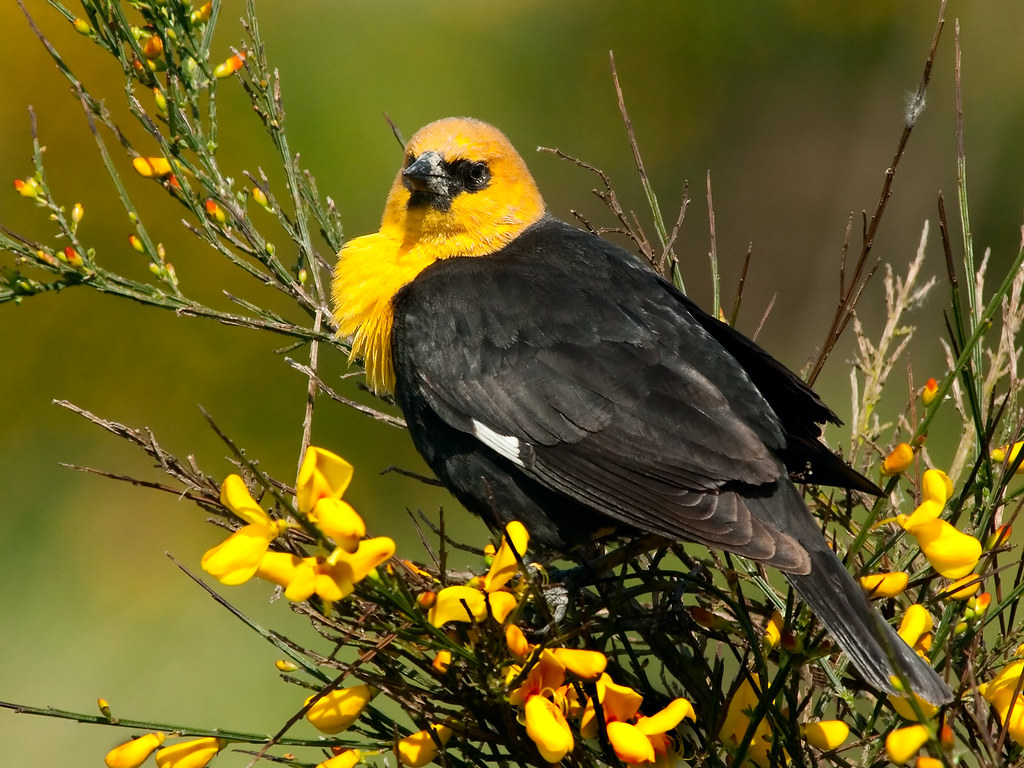
Yellow-headed Blackbirds can be spotted in Wisconsin during summer, from May to August. They appear in 3% of summer checklists.
Male Yellow-headed Blackbirds are striking with their bright yellow heads and black bodies. Females have brownish plumage with streaks and paler yellow heads.
Scientific name: Xanthocephalus xanthocephalus
Length: 9.8-11.0 inches (25-28 cm)
Weight: 3.5-5.3 ounces (100-150 g)
Wingspan: 17.7-19.7 inches (45-50 cm)
Yellow-headed Blackbirds breed in the western United States and parts of Canada. They migrate to southwestern US states and northern Mexico for the winter.
You can find Yellow-headed Blackbirds in marshes, wetlands, and areas with tall grasses, where they forage for insects and feed on seeds.
Song of the Yellow-headed Blackbird:
Credit: Richard E. Webster, XC366710. Available at www.xeno-canto.org/366710.
Nests of Yellow-headed Blackbirds are built by females in cattails or other emergent vegetation, typically over water. They are constructed using grasses, sedges, and other plant materials, and are lined with softer materials such as finer grasses and feathers. They lay around three to five eggs, which hatch after approximately two weeks. The young birds fledge the nest after another two weeks.
19. Canada Warbler
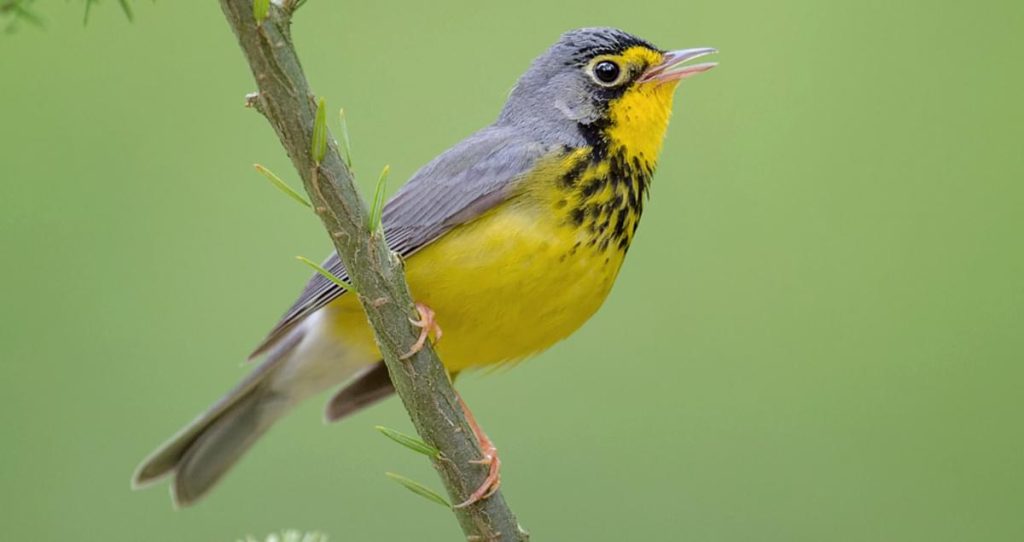
Canada Warblers can be spotted in Wisconsin during migration, primarily in spring and fall. They are recorded in 4% of checklists during migration.
Canada Warblers have bluish-gray upperparts, yellow undersides, and a distinctive necklace of black streaks on their yellow throats and breasts.
Scientific name: Cardellina canadensis
Length: 4.3-5.1 inches (11-13 cm)
Weight: 0.4-0.5 ounces (10-15 g)
Wingspan: 7.1-7.9 inches (18-20 cm)
Canada Warblers breed in the boreal forests of Canada and northeastern United States. During migration, they can be observed in various parts of the United States.
You can find Canada Warblers in moist forests, where they forage for insects by actively searching among the foliage.
Song of the Canada Warbler:
Credit: Richard E. Webster, XC366742. Available at www.xeno-canto.org/366742.
Nests of Canada Warblers are built by females on the ground, typically at the base of shrubs or in mossy areas. They are constructed using grasses, mosses, and other fine materials, and are lined with softer materials such as feathers and hair. They lay around four to five eggs, which hatch after approximately two weeks. The young birds fledge the nest after another two weeks.
20. Prothonotary Warbler
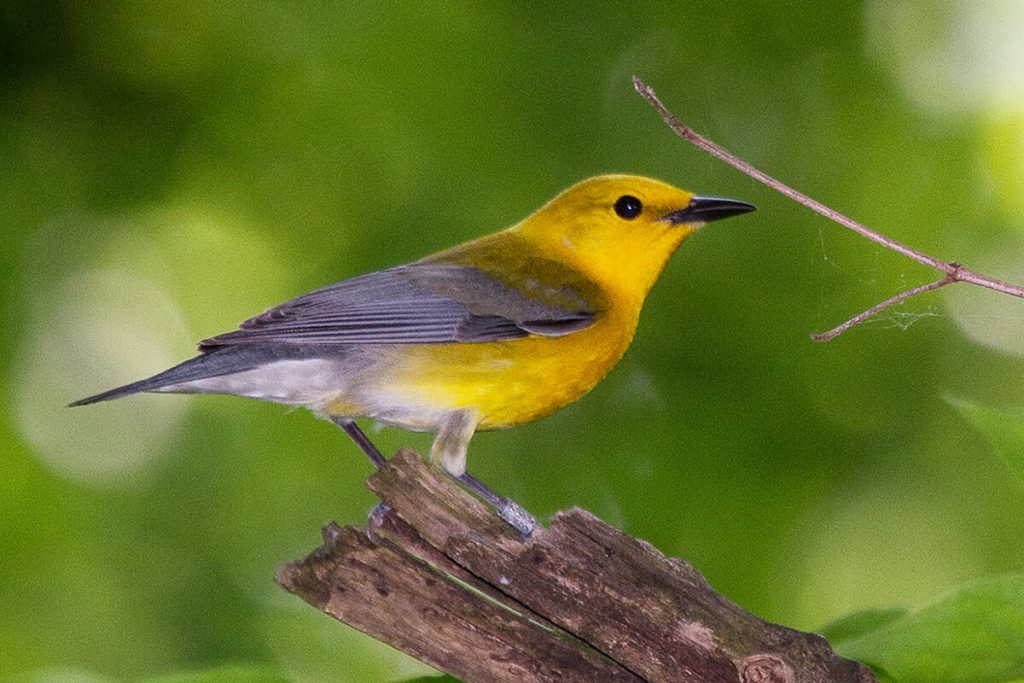
Prothonotary Warblers can be spotted in Wisconsin during migration, primarily in spring and fall. They are recorded in 3% of checklists during migration.
Prothonotary Warblers have bright yellow plumage on their upperparts and undersides, with bluish-gray wings and tail. Males have a distinctive orange crown, while females display paler markings.
Scientific name: Protonotaria citrea
Length: 4.3-5.1 inches (11-13 cm)
Weight: 0.3-0.4 ounces (9-11 g)
Wingspan: 7.1-7.9 inches (18-20 cm)
Prothonotary Warblers breed in the southeastern United States and parts of Canada. During migration, they can be observed in various parts of the United States.
You can find Prothonotary Warblers in wetland areas, including swamps and flooded forests, where they forage for insects by gleaning from tree branches and vegetation.
Song of the Prothonotary Warbler:
Credit: Mike Nelson, XC481946. Available at www.xeno-canto.org/481946.
Nests of Prothonotary Warblers are built by females in tree cavities or nest boxes near water, typically over
or near the water surface. They are constructed using grasses, leaves, and other plant materials, and are lined with softer materials such as feathers and hair. They lay around four to seven eggs, which hatch after approximately two weeks. The young birds fledge the nest after another two weeks.
Please note that the percentage of occurrence in checklists provided is an estimate and can vary based on the specific location and time of observation.
21. Hooded Warbler
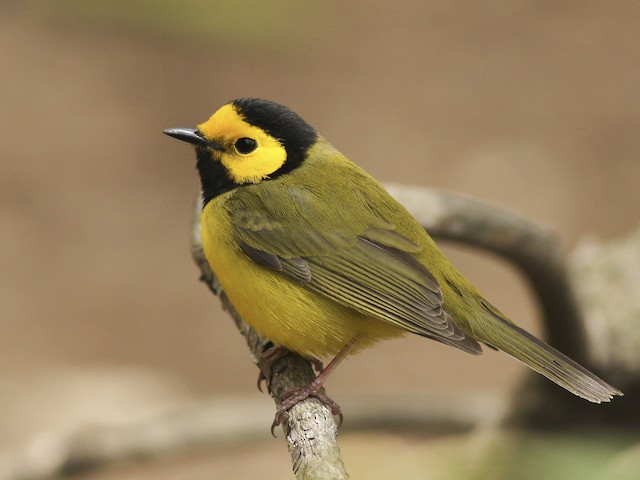
Hooded Warblers can be spotted in Wisconsin during migration, primarily in spring and fall. They are recorded in 2% of checklists during migration.
Hooded Warblers have bright yellow plumage on their undersides and a black hood covering their head and neck. Males have a distinctive black mask and throat, while females display lighter markings.
Scientific name: Setophaga citrina
Length: 4.3-5.1 inches (11-13 cm)
Weight: 0.3-0.4 ounces (9-11 g)
Wingspan: 6.7-7.5 inches (17-19 cm)
Hooded Warblers breed in the eastern United States and parts of Canada. During migration, they can be observed in various parts of the United States.
You can find Hooded Warblers in dense undergrowth and forest edges, where they forage for insects by actively searching among the vegetation.
Song of the Hooded Warbler:
Credit: Andrew Spencer, XC557714. Available at www.xeno-canto.org/557714.
Nests of Hooded Warblers are built by females low to the ground, typically in shrubs or saplings. They are constructed using grasses, leaves, and other plant materials, and are lined with softer materials such as fine grasses and hair. They lay around three to five eggs, which hatch after approximately two weeks. The young birds fledge the nest after another two weeks.
22. Western Meadowlark

Western Meadowlarks can be spotted in Wisconsin during migration, primarily in spring and fall. They are recorded in 2% of checklists during migration.
Western Meadowlarks are medium-sized birds with bright yellow undersides and brownish plumage on their upperparts. They have a distinctive black “V” mark on their chests.
Scientific name: Sturnella neglecta
Length: 7.1-10.2 inches (18-26 cm)
Weight: 3.9-6.3 ounces (110-180 g)
Wingspan: 14.2-16.5 inches (36-42 cm)
Western Meadowlarks breed in western and central North America, including parts of Canada. They migrate to southern US states and Mexico for the winter.
You can find Western Meadowlarks in grasslands, prairies, and agricultural fields, where they forage for insects and feed on seeds.
Song of the Western Meadowlark:
Credit: Mike Nelson, XC452480. Available at www.xeno-canto.org/452480.
Nests of Western Meadowlarks are built by females on the ground, typically in grassy areas with some cover. They are constructed using grasses and other plant materials, and are lined with softer materials such as fine grasses and hair. They lay around four to six eggs, which hatch after approximately two weeks. The young birds fledge the nest after another two weeks.
23. White-eyed Vireo
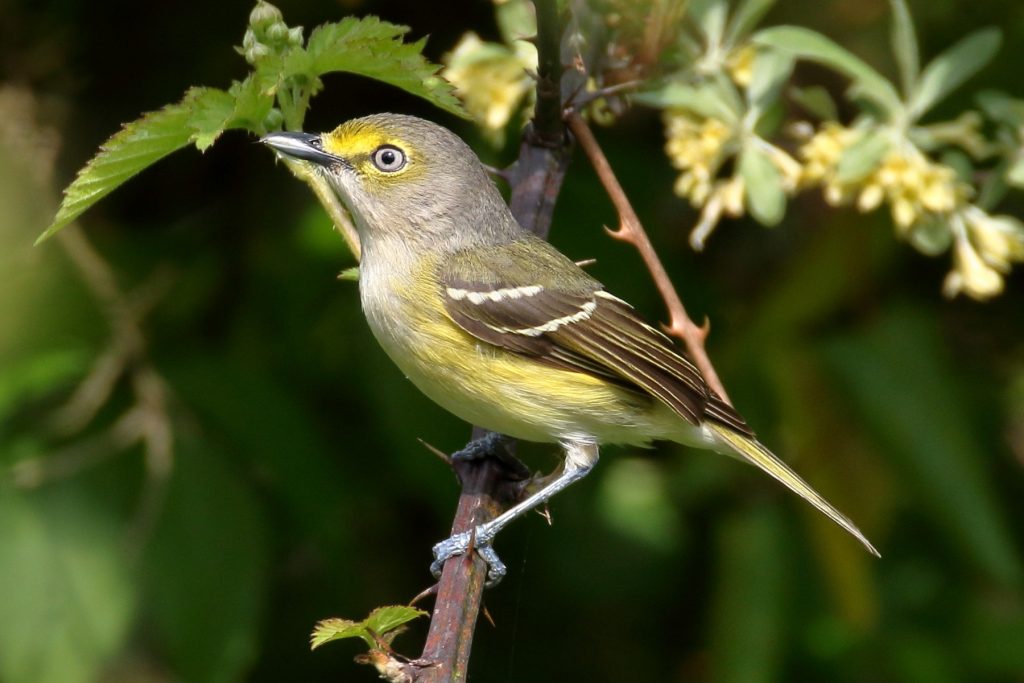
White-eyed Vireos can be spotted in Wisconsin during migration, primarily in spring and fall. They are recorded in 1% of checklists during migration.
White-eyed Vireos have bright yellow-green plumage on their upperparts and a yellow throat. They have a distinctive white eye ring and a gray cap.
Scientific name: Vireo griseus
Length: 4.7-5.1 inches (12-13 cm)
Weight: 0.4-0.5 ounces (11-14 g)
Wingspan: 7.1-7.9 inches (18-20 cm)
White-eyed Vireos breed in the southeastern United States and parts of Mexico. During migration, they can be observed in various parts of the United States.
You can find White-eyed Vireos in dense shrubs and thickets, where they forage for insects by actively searching among the foliage.
Song of the White-eyed Vireo:
Credit: Mike Nelson, XC452484. Available at www.xeno-canto.org/452484.
Nests of White-eyed Vireos are built by females in shrubs or small trees, typically at a low height. They are constructed using grasses, plant fibers, and other plant materials, and are lined with softer materials such as fine grasses and hair. They lay around three to five eggs, which hatch after approximately two weeks. The young birds fledge the nest after another two weeks.
24. Evening Grosbeak

Evening Grosbeaks can be spotted in Wisconsin during winter. They are recorded in 3% of winter checklists.
Evening Grosbeaks are large, stocky birds with a bright yellow body, black wings with white patches, and a large, powerful beak. Females have more subdued plumage with grayish tones.
Scientific name: Coccothraustes vespertinus
Length: 6.3-8.3 inches (16-21 cm)
Weight: 1.9-2.6 ounces (55-75 g)
Wingspan: 12.6-14.6 inches (32-37 cm)
Evening Grosbeaks breed in coniferous forests of North America, including parts of Canada. During winter, they can migrate to various parts of the United States, including Wisconsin.
You can find Evening Grosbeaks in forested areas, where they forage for seeds, particularly those from conifer trees.
Call of the Evening Grosbeak:
Credit: Andrew Spencer, XC557703. Available at www.xeno-canto.org/557703.
Nests of Evening Grosbeaks are built by females in trees, typically using twigs, roots, and other plant materials. They lay around two to four eggs, which hatch after approximately two weeks. The young birds fledge the nest after another two weeks.
Please note that the presence of Evening Grosbeaks in Wisconsin during winter can vary from year to year, depending on food availability and other factors.
25. Yellow-rumped Warbler
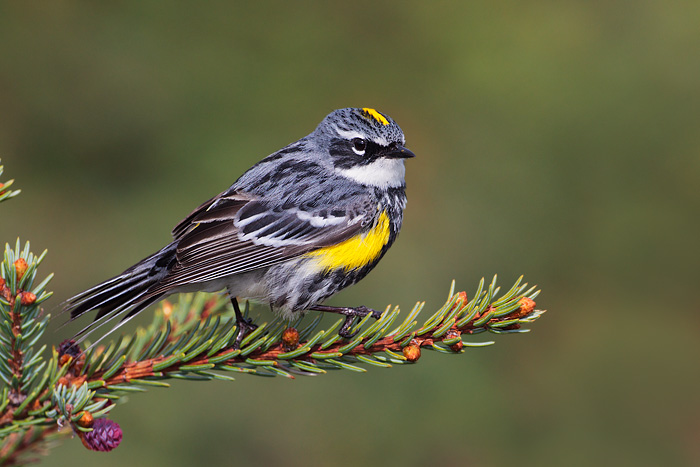
Yellow-rumped Warblers can be spotted in Wisconsin during migration, primarily in spring and fall. They are recorded in 15% of checklists during migration.
Yellow-rumped Warblers have grayish plumage on their upperparts, with a bright yellow throat, sides, and rump. They have distinctive patches of yellow on their wings.
Scientific name: Setophaga coronata
Length: 5.1-5.9 inches (13-15 cm)
Weight: 0.4-0.5 ounces (12-14 g)
Wingspan: 7.9-9.1 inches (20-23 cm)
Yellow-rumped Warblers breed in northern North America, including parts of Canada. During migration, they can be observed in various parts of the United States.
You can find Yellow-rumped Warblers in various habitats, including forests, woodlands, and even urban areas, where they forage for insects and feed on berries.
Song of the Yellow-rumped Warbler:
Credit: Andrew Spencer, XC557686. Available at www.xeno-canto.org/557686.
Nests of Yellow-rumped Warblers are built by females in trees, typically using grasses, plant fibers, and
other plant materials. They lay around three to five eggs, which hatch after approximately two weeks. The young birds fledge the nest after another two weeks.
26. Palm Warbler

Palm Warblers can be spotted in Wisconsin during migration, primarily in spring and fall. They are recorded in 5% of checklists during migration.
Palm Warblers have brownish plumage on their upperparts, with a bright yellow throat, undersides, and rump. They have a distinctive pattern of yellow and brown on their head and chest.
Scientific name: Setophaga palmarum
Length: 4.7-5.1 inches (12-13 cm)
Weight: 0.3-0.4 ounces (9-11 g)
Wingspan: 6.7-7.9 inches (17-20 cm)
Palm Warblers breed in the boreal forests of North America, including parts of Canada. During migration, they can be observed in various parts of the United States.
You can find Palm Warblers in various habitats, including wetlands, marshes, and forest edges, where they forage for insects and feed on berries.
Song of the Palm Warbler:
Credit: Andrew Spencer, XC557683. Available at www.xeno-canto.org/557683.
Nests of Palm Warblers are built by females on the ground, typically in grassy areas with some cover. They are constructed using grasses, plant fibers, and other plant materials, and are lined with softer materials such as fine grasses and hair. They lay around four to five eggs, which hatch after approximately two weeks. The young birds fledge the nest after another two weeks.
27. Magnolia Warbler
Magnolia Warblers can be spotted in Wisconsin during migration, primarily in spring and fall. They are recorded in 7% of checklists during migration.
Magnolia Warblers have black plumage on their upperparts, with a bright yellow throat, undersides, and rump. They have a distinctive pattern of white and black on their wings.
Scientific name: Setophaga magnolia
Length: 4.7-5.1 inches (12-13 cm)
Weight: 0.3-0.4 ounces (9-11 g)
Wingspan: 7.1-7.9 inches (18-20 cm)
Magnolia Warblers breed in the boreal forests of North America, including parts of Canada. During migration, they can be observed in various parts of the United States.
You can find Magnolia Warblers in various habitats, including forests, woodlands, and even gardens, where they forage for insects among the foliage.
Song of the Magnolia Warbler:
Credit: Andrew Spencer, XC557677. Available at www.xeno-canto.org/557677.
Nests of Magnolia Warblers are built by females on the ground or low to the ground, typically using grasses, plant fibers, and other plant materials. They lay around four to five eggs, which hatch after approximately two weeks. The young birds fledge the nest after another two weeks.
28. Wilson’s Warbler
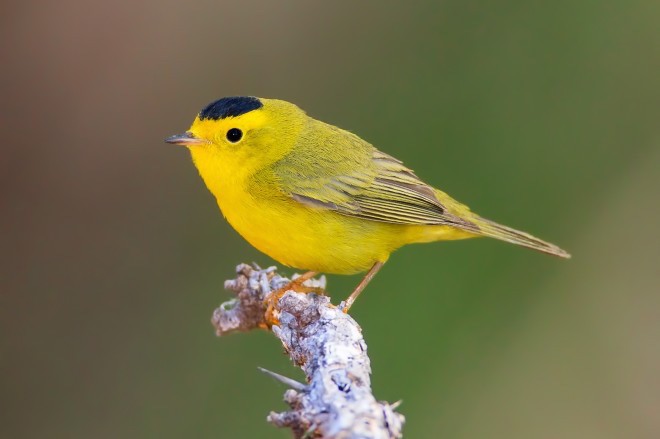
Wilson’s Warblers can be spotted in Wisconsin during migration, primarily in spring and fall. They are recorded in 6% of checklists during migration.
Wilson’s Warblers have bright yellow plumage on their undersides, with olive-green upperparts and a black cap. Males have a distinctive black mask, while females display paler markings.
Scientific name: Cardellina pusilla
Length: 4.3-4.7 inches (11-12 cm)
Weight: 0.3-0.4 ounces (9-11 g)
Wingspan: 6.7-7.5 inches (17-19 cm)
Wilson’s Warblers breed in western North America, including parts of Canada. During migration, they can be observed in various parts of the United States.
You can find Wilson’s Warblers in various habitats, including forests, woodlands, and shrubby areas, where they forage for insects among the foliage.
Song of the Wilson’s Warbler:
Credit: Andrew Spencer, XC557674. Available at www.xeno-canto.org/557674.
Nests of Wilson’s Warblers are built by females low to the ground, typically in dense shrubs or bushes. They are constructed using grasses, plant fibers, and other plant materials, and are lined with softer materials such as fine grasses and hair. They lay around three to five eggs, which hatch after approximately two weeks. The young birds fledge the nest after another two weeks.
We hope this comprehensive guide helps you identify the yellow birds you spot in Wisconsin. Enjoy birdwatching and exploring the vibrant avian diversity in your area!